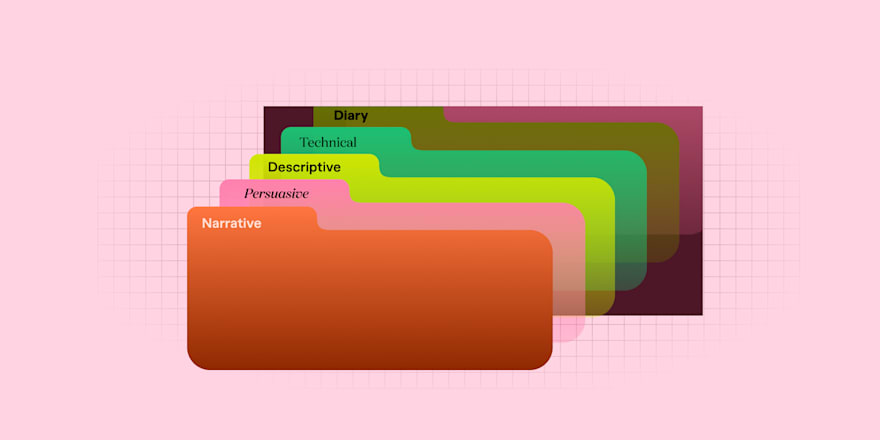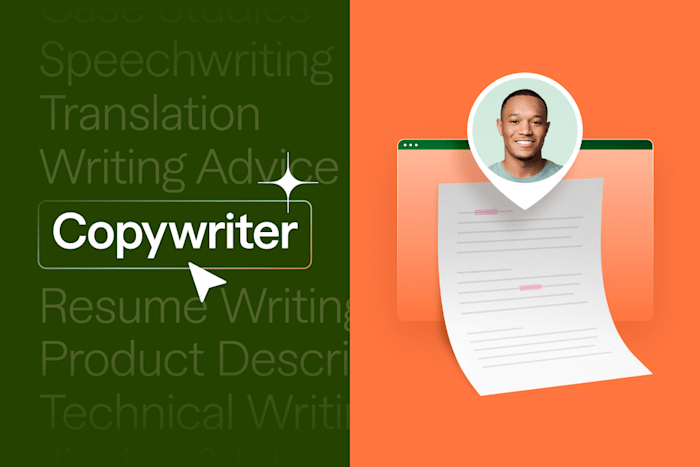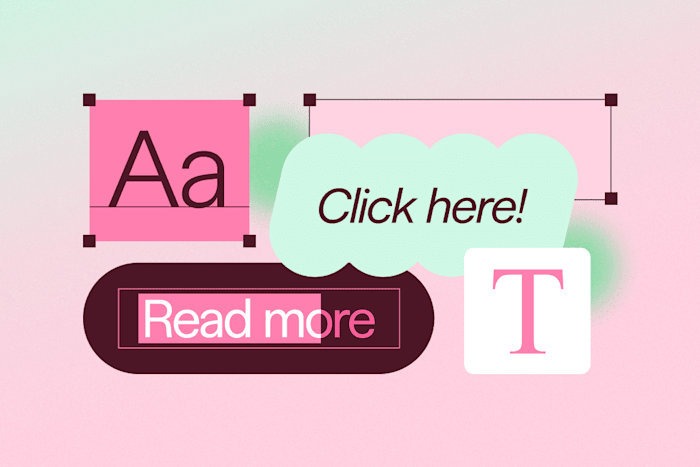What Are the 4 Types of Writing Styles?
This article explores four writing styles with examples and tips to master them. Whether for work, play, or self-discovery, these styles help you communicate effectively.
 January 23, 2025
January 23, 2025 11 minute reading
11 minute reading
Words express feelings, share knowledge, and entertain, but skilled writers can use them to persuade, inspire, and even change history. This power can be used in different ways, which is where various writing types come in.
The four major types of writing—creative, professional, web-based, and specialized—each serve distinct purposes. Whether you're a seasoned writer expanding your horizons or a newbie finding your groove, understanding the four types of writing styles helps you master your craft.
This article explores modern types of writing, their characteristics, examples, and how learning each type can turn you into the writer you want to be.
4 types of writing styles
Traditionally, the four types of writing are expository, descriptive, persuasive, and narrative. However, the kinds of writing have shifted with the times. Now, we have creative writing, professional writing, web-based writing, and specialized writing. Let’s explore each style below.
Creative writing
Creative writing is where your imagination runs wild, and anything goes. Subtypes of creative writing include:
Fiction writing
Writing fictional novels is all about weaving plots, developing characters, and creating lively worlds. While complex plots aren't necessary for great fiction, vivid descriptions, compelling characters, and engaging dialogue are key.
Different genres of fiction follow their own set of conventions. For instance, an intricate plot is crucial in mysteries or thrillers, but it’s less central in literary fiction. Science fiction has more expansive world-building than historical fiction.
Sub-genres add another layer of complexity to fiction writing. Horror, for example, branches into gothic, psychological, supernatural, and more.
With fiction writing, you can mix and match genres, sub-genres, and tropes—as long as it works. Some examples include:
James Thurber’s short story "The Secret Life of Walter Mitty," which blends fantasy and literary fiction
Antoine de Saint-Exupéry’s novella "The Little Prince," which fluidly merges fantasy, children's literature, and satire
Gabriel Garcia Marquez’s novel "One Hundred Years of Solitude," an example of magical realism combining elements of fantasy and historical fiction
Stephanie Meyer’s "Twilight" series, which fuses young adult, romance, horror, and fantasy genres
Poetry
Poetry is arguably the most evocative form of writing, using language to stir emotions and paint vivid images. Poems can tell stories, explore themes and ideas, or focus purely on the art of language itself. In that sense, poetry is even less bound by the conventions that govern fiction.
Find a Poetry Writer for Hire
Some poems adhere strictly to established rules, while others break them. A poem can be as brief as a few lines or extend to hundreds of pages.
Here are just a few ways you could write a poem:
Sonnets: 14 lines using an iambic pentameter
Haikus: 3 lines with a 5-7-5 syllable pattern
Villanelles: 19 lines with a specific rhyme scheme and repeating lines
Elegies: Poems that mourn or lament
Epics: Long, narrative poems usually about heroic deeds
Rap or spoken word: Poetry written to be performed orally
For examples of how to navigate or even challenge the boundaries of a specific poetic form, examine these classics:
"Do Not Go Gentle Into That Good Night" by Dylan Thomas (villanelle)
"Shall I Compare Thee to a Summer's Day?" by William Shakespeare (sonnet)
"The Iliad" and "Odyssey" by Homer (epic)
"Paid in Full" by Rakim (rap)
Want to ditch the rules entirely? Free verse offers the perfect outlet for unrestrained creativity. To get a sense of the freedom it allows, try reading these two contemporary poets side by side: Patricia Lockwood's "Rape Joke" and Rupi Kaur's "milk and honey" collection.
Are you struggling to articulate complex emotions or use literary devices effectively? Then consider working with a poet on Fiverr who can do some of the heavy lifting for you. They can transform those elusive feelings into a beautifully crafted poem—whether it's an ode to a loved one, an elegy for a lost pet, or a simple haiku about your morning coffee.
Screenwriting
Screenwriting is about crafting dialogue and scenes that bring movies and TV shows to life. It has a more formal structure, typically following a three-act arc: set-up, conflict, and resolution. The art of screenwriting lies in getting the flow right between these acts.
Classic screenplays to study include:
"Chinatown" by Robert Towne
"The Godfather" by Mario Puzo and Francis Ford Coppola
"Annie Hall" by Woody Allen and Marshall Brickman
"Dr. Strangelove" by Stanley Kubrick, Peter George, and Terry Southern
TV scripts share common elements with movie scripts. However, they have added challenges like commercial breaks, act transitions, and cold opens. TV pilots introduce characters, establish the premise, and tease future storylines, all while aiming for a series pickup.
Great examples of TV pilot scripts that expertly balance these elements are:
"Breaking Bad" by Vince Gilligan, Sam Catlin, and Moira Walley-Beckett
"Barry" by Alec Berg and Bill Hader
"Arrested Development" by Mitchell Hurwitz
Collaboration is notably more common in screenwriting than other writing forms, particularly for high-budget productions. Producers, directors, and actors can also change the screenplay during shooting.
Personal essays
This is a type of nonfiction writing that focuses on an author’s opinions, personal experiences, and reflections across a vast range of topics. In personal essay writing, expertise is secondary to finding a fresh and compelling perspective to tell your story. While facts are involved, it's your interpretation and response to those facts that shape this type of writing.

Pexels
For example, a personal essay on living off the land will resonate differently when written by someone who's lived in the city their whole life versus someone who's spent years farming and gardening. Both essays can be good—but likely in different ways, each appealing to different audiences.
This writing type offers flexibility in terms of tone and style, whether terse or long-winded, academic or colloquial, serious or humorous. What matters is having a clear voice that's engaging to your readers.
Here are a few examples of personal essays:
"Once More to the Lake" by E.B. White – White visits the lake he visited with his father when he was a boy, this time with his son, and muses about fatherhood, country, and death.
"Notes of a Native Son" by James Baldwin – Baldwin writes about the death of his father and the surrounding racial turmoil in the United States.
"A Few Words About Breasts" by Nora Ephron – Ephron uses her insecurities about her body to examine cultural beauty standards and the societal pressures placed on women.
Creative nonfiction
Creative nonfiction writing closely resembles personal essay writing. However, it has a stronger emphasis on facts and gives you the freedom to present those facts using fictional techniques like dialogue, scene-setting, and authorial reflection.
With creative nonfiction, you can tackle complex themes and narratives in an authentic, engaging manner that won't leave readers feeling like they're reading a textbook.
Some great examples that illustrate this approach are:
"In Cold Blood" by Truman Capote – In this true-crime novel, Capote details the brutal murder of an entire family in rural Kansas and its aftermath.
"The Year of Magical Thinking" by Joan Didion – After her husband's sudden death, Didion explores the complexities of grief and loss through the lens of her own experiences.
"Into Thin Air" by Jon Krakauer – A firsthand account of a disastrous Mount Everest expedition that sheds light on the dangers and ethics of commercialized mountain climbing.
"A Supposedly Fun Thing I'll Never Do Again" by David Foster Wallace – The famously neurotic author dives headfirst into the excesses of a luxury cruise and struggles to find meaning in the spectacle.
Professional writing
This type of writing is commonly used in work environments. It prioritizes clarity, conciseness, accuracy, and the right tone for your audience.
Subtypes of professional writing include:
Business writing
Business writing is about delivering a business’s message efficiently and persuasively. The goal is to move from point A to point B with clarity and impact.
Examples of this are:
Internal emails
Reports
Shareholder letters
Proposals
Memos
Letter of recommendation
Clarity and brevity are key in business writing, but formal language and jargon can also be used to convey authority and professionalism. Business writers have to strike the right balance between being approachable and projecting expertise and credibility.
Technical writing
Technical writing focuses on giving readers clear and straightforward explanations or directions. It aims to help readers better understand a complex topic. Whether directed at professionals in the same field or the general public, the goal is to deliver precise, complete information, not entertainment.
Find an Expert Technical Writer for Hire
In terms of format, clear headings and subheadings are used to make it easier for readers to find specific information. This is especially helpful when following steps in tasks like furniture assembly or troubleshooting. Charts and diagrams further enhance comprehension for visual learners.
Examples of technical writing include:
User manuals
Instruction manuals
Scientific writing
Research reports
Lab reports
Of all writing styles, technical writing is the most straightforward. The best technical writers can inject personality into their work, but the priority is always clarity and sharing information with readers.
Technical writing requires a writer who thrives within its constraints. If you'd rather focus on creative work, consider partnering with a freelance for technical writing services on Fiverr who can handle the technical details for you.
Academic writing

Pexels
This subtype of professional writing is all about research, analysis, and argumentation, withobjectivity and precision as its core principles. The tone is formal and authoritative. Supporting your arguments with solid evidence is essential to strengthen your claims and demonstrate expertise.
In academic writing, getting familiar with major citation styles is a must. These include MLA (Modern Language Association), APA (American Psychological Association), and Chicago.
Examples of academic writing include:
Research papers
Theses
Dissertations
Journal articles
Academic writing maintains a serious tone, even in titles and headings. Titles are straightforward, while headings follow a structured hierarchy to guide the reader through the material.
Journalistic writing
Journalistic writing, prevalent in print and online media, delivers clear, factual information to the general public. Accuracy is key, yet engaging readers is vital, too. In the social media era, a touch of creativity is beneficial, using powerful words and vivid descriptions to make stories come alive.
Journalistic writing involves providing details on the what, who, when, where, and why of a story. Framing the story is also crucial to provide context for readers. Including quotes from sources, experts, or eyewitnesses adds credibility and provides different perspectives. Meticulous record-keeping and fact-checking are other essential characteristics.
The goal of writing news stories is to stay objective and unbiased. However, some outlets offer leeway for creative journalism, depending on the style and publication. Notable examples of this type of writing include:
"The Case for Reparations" by Ta-Nehisi Coates
"Hiroshima: The Aftermath" by John Hersey
"Behind the Beautiful Forevers" by Katherine Boo
Content writing
Content writing broadly refers to any written content published on different platforms, primarily digital. It can be used for various purposes, from informing and educating readers to entertaining them. Some examples include:
Industry-specific articles that inform and engage
Website copy to promote a company's services or products
A welcome page or About Us page on a company's website
Product descriptions for an e-commerce site
Clarity and accessibility are key, though some jargon may be necessary depending on your audience. For certain businesses, like a plumbing company, technical terms like "elbow joint" and "threaded coupling" are essential for conveying expertise.
Find a Content Strategy Expert for Hire
Web-based writing
Web-based writing refers to creating written material to be published online.
Subtypes of web-based writing include:
Blog posts
Blog posts are written for online audiences, but they tend to feature a more personal tone than professional content. Written mainly from an author's point of view, as opposed to a company’s, blog posts cover a wider range of topics. That means more room for creativity.
Some common elements of blog writing include:
A more conversational tone and personal voice
Integration of multimedia such as images, videos, or infographics to enhance the post
Encouraging reader engagement through comments and social media sharing
Examples of blog posts include personal blog posts, lifestyle blog posts, how-to articles, and opinion pieces.
Social media content
Social media writing refers to creating written material to be shared on various social media platforms. With strict character limits and constantly changing algorithms, writing for social media requires a more strategic approach than blog posts or content writing.
Even the simplest of social media posts require strategic planning. Key elements include:
Headlines or captions that grab attention
Concepts that resonate with current cultural trends
Visuals that stand out and make an impact in a split second of scrolling
Calls-to-action that prompt users to take action
Punchy line breaks or emojis to break up blocks of text
Social media content condenses complex ideas into a brief, impactful message. Examples of social media content are Instagram Reels, X (formerly Twitter) posts, Facebook posts, TikTok videos, and LinkedIn posts.
Email writing
Email writing involves composing messages to be sent via electronic mail, whether for purposes like professional, marketing, or personal. Principles from blog writing and social media writing apply to email writing, too. What's different is that you're writing for an audience of one.
The purpose of email writing can be to inform, persuade, or sell, depending on the goal of the email. The tone is typically warm and professional, encouraging readers to take action. The message should be clear and concise and include a strong call to action.
For email writing to be effective, you must have a clear subject line to hook recipients and help them understand the primary purpose of the email quickly. An organized structure promotes readability, while personalization helps you build relationships with the recipients and make the email more engaging.
Some examples of email writing are:
Informative email
Persuasive email
Sales email
Follow-up email
Thank you email
UX writing
UX writing is all about crafting text for websites and apps, ensuring readability and seamless navigation. The aim here is to help users navigate digital spaces without a hitch. This means keeping the language straightforward, avoiding confusing jargon, and aligning with the brand’s tone.
Key examples of UX writing:
Microcopy: These are short writing pieces, like button labels or error messages.
Navigation and labeling: UX writers make sure menus and tabs are clearly labeled so people can find their way around easily.
Onboarding and instructional content: These are simple instructions that guide users.
Effective UX writing enhances usability and creates a seamless experience. However, if it’s not within your skill set, Fiverr's UX writers can help you with this.
SEO content

Pexels
SEO writing is essentially content writing or blog posts but with a strategic focus. The goal isn’t just to create engaging material. Instead, it's to get your content noticed by search engines and users alike.
Effective SEO writing entails incorporating well-researched keywords, but it’s also essential to prioritize including high-quality and valuable content. Here are the characteristics of excellent SEO content writing:
Targeted keywords: Use keywords that people search for and incorporate them naturally throughout your content.
Engaging and valuable content: Your content should be interesting and informative or educational.
On-page optimization: Tweak titles, headings, URLs, and meta descriptions to enhance visibility in search results.
Strategic linking: Add links to other pages on your site or trusty external sites.
Any content can be SEO-optimized to provide value and make it relevant to readers. Some common examples include e-commerce website content, blog posts, website copy, product descriptions, landing pages, FAQ pages, and even social media posts.
Specialized writing forms
Specialized writing forms serve a specific purpose or audience, often with unique conventions and styles. Examples include:
Grant writing
Crafting grant proposals involves convincing funders to invest in your project or cause. You need to express your objectives clearly and why they’re worth supporting.
Key elements of grant writing include:
A clear and concise summary of the project or program
Detailed information on the organization's mission, goals, and track record
A budget breakdown and justification for the funding request
Information about potential outcomes and impact of the project
Examples of grant writing include nonprofit, government, educational, and research grants.
Legal writing
Legal writing is a distinct form of communication used for contracts, court documents, legal opinions, and other legal documents. Precision in words and structure is crucial since minor errors can lead to significant legal implications.
Key elements of legal writing include:
Use of formal language with specific terminology
Clear organization and structure
Objectivity and neutrality in tone
Accurate citations for references to laws or cases
Medical writing
Medical writing involves crafting a wide range of documents related to healthcare. These include research studies, medication information leaflets, patient education materials, and medical reports. To excel in medical writing, it's crucial to have a good grasp of medical terms and the skill to break down complex details for diverse audiences.
Key elements of medical writing include:
Use of technical language and jargon specific to the medical field
A focus on accuracy and objectivity
Adherence to strict guidelines for specific subtypes of medical writing, such as randomized clinical trials, regulatory submissions, and patient education materials
Copywriting
Copywriting is about using words to capture attention and drive action, particularly in sales. To get it right, it’s essential to understand consumer psychology and what motivates their decision-making. The key lies in crafting deeply resonating messages, sparking interest, and prompting immediate action like signing up for a newsletter or buying a product.
One of the key characteristics of effective copywriting is having catchy headlines and hooks that grab attention. Knowing your audience and tailoring your message to their needs is also crucial. Using convincing language and strong calls to action are essential for encouraging the audience to take the desired next steps. Additionally, it’s about keeping a consistent brand voice across all platforms.
Examples of awesome copywriting can be seen in different formats, such as:
Famous brand slogans like Nike's "Just Do It" or Subway's "Eat Fresh"
Memorable taglines such as McDonald's "I'm Lovin' It" or Mastercard's "Priceless"
Product descriptions that effectively spotlight standout features
Engaging social media posts and scripts that build a connection with followers
Persuasive sales emails that motivate readers to take action
The best copy is deceptively simple. If you'd rather skip the headache of grinding down thousands of words into the perfect snippet, professional copywriting services from Fiverr can take over so you can focus on other important tasks.
Speech writing
Speech writing involves the creation of written content to be delivered as a speech or presentation. It requires excellent communication skills and the ability to craft a message that is engaging, memorable, and impactful for the audience.
Find an Expert Speech Writer for Hire
Key elements of speech writing include:
A clear understanding of the purpose and goal of the speech
Use of storytelling techniques to capture and maintain audience attention
Incorporation of rhetorical devices such as repetition, metaphors, and humor
Tailoring the language and tone to fit the speaker's style and delivery
Speech writing examples include political, corporate, motivational, and commencement speeches.
Choosing the right writing style
Mastering every writing style may seem challenging. However, having a solid foundation on each style is enough for you to get your message across effectively.
When choosing the right style, consider:
Who you're writing for: Tailor your tone and language depending on your audience.
Why you're writing: Each style serves its purpose—inform, convince, entertain, or teach. Choose one that aligns with your writing goals.
Authenticity: Be yourself and use your strengths. Mimicking others can make your writing feel forced.
Context: This influences your style. Blog posts are typically casual and friendly, while formal reports require professionalism and detail.
Let's see how this works in practice.
Say you're an academic ghostwriter transitioning to SEO content. You're used to in-depth research and content, but now you need to keep things light and engaging. This will require adjusting your tone, such as focusing on readability, simplifying the language, and keeping your users’ needs in mind.
AI tools in content marketing can help you with your writing process by analyzing your audience data and recommending the most effective tone for your content. Some tools can also help optimize your content by recommending which relevant keywords to include.
Buy and sell writing services on Fiverr
You can quickly familiarize yourself with different writing styles, but that might not be enough for a project requiring immediate attention. That's exactly why the Fiverr marketplace exists.
Get matched with the perfect writer for your needs withFiverr. Every kind of service is here, including ghostwriting services, SEO writing, book and eBook writing services, professional industry writing services, product description writers, proofreading services, grant proposal writers, video script services, and so much more.
The same goes for those on the other side of the coin: writers.
Are you an established writer looking for new niches to conquer? Or perhaps you’re a new writer looking to explore fresh opportunities? There’s no better stage to showcase what you've got than Fiverr, a platform that connects you with clients from all over the world.
Types of writing FAQ
What are the five major writing styles?
The five main types of writing are creative, narrative, descriptive, expository, and persuasive.
Creative writing isdriven by imagination, with the writer using their craft to keep the reader hooked. Narrative writing tells a story, whether based on real life or fiction. It’s often used in books, memoirs, and journalistic pieces.
Descriptive writing paints pictures with words, helping readers experience a scene or setting in their mind’s eye. Expository writing is meant to inform or teach readers about a topic. It’s commonly used in textbooks, news articles, and reports. Finally, a persuasive piece aims to sway readers into agreeing with an opinion or taking action using evidence and logical arguments. Legal writing and opinion pieces often use this style.
What are the 4 types of writing skills?
The four essential writing skills are:
Grammar, punctuation, spelling, and word choice – These form the foundation of clear writing.
Research – Adds depth and credibility, even in creative work, by providing accurate details
Outlining – Helps organize thoughts and guide readers, making content easier to follow
Revising – Polishes the work, catches errors, and refines the style. By revising, you enhance your writing’s clarity and impact.
What are the 4 types of creative writing?
The four main types of creative writing are fiction, poetry, screenwriting, personal essays, and creative nonfiction. Fiction involves breathing life into characters and stories. Poetry is the expressive side of writing, evoking emotions and creating vivid pictures with words.
Screenwriting is the backbone of movies and TV shows, where sharp dialogue and dynamic scenes are essential to keep audiences engaged. The fourth type combines personal essays and creative nonfiction—two sides of the same coin. Personal essays reflect individual experiences and views. Meanwhile, creative nonfiction uses storytelling tools like dialogue, internal narratives, and symbolism to address factual content in a dynamic, engaging way.



